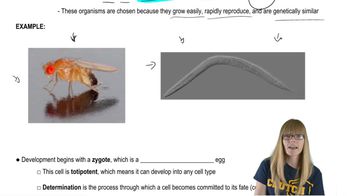Which of the following polymerases is responsible for transcribing mRNA in eukaryotes?
Table of contents
- 1. Introduction to Genetics51m
- 2. Mendel's Laws of Inheritance3h 37m
- 3. Extensions to Mendelian Inheritance2h 41m
- 4. Genetic Mapping and Linkage2h 28m
- 5. Genetics of Bacteria and Viruses1h 21m
- 6. Chromosomal Variation1h 48m
- 7. DNA and Chromosome Structure56m
- 8. DNA Replication1h 10m
- 9. Mitosis and Meiosis1h 34m
- 10. Transcription1h 0m
- 11. Translation58m
- 12. Gene Regulation in Prokaryotes1h 19m
- 13. Gene Regulation in Eukaryotes44m
- 14. Genetic Control of Development44m
- 15. Genomes and Genomics1h 50m
- 16. Transposable Elements47m
- 17. Mutation, Repair, and Recombination1h 6m
- 18. Molecular Genetic Tools19m
- 19. Cancer Genetics29m
- 20. Quantitative Genetics1h 26m
- 21. Population Genetics50m
- 22. Evolutionary Genetics29m
10. Transcription
Transcription in Eukaryotes
Problem 1d
Textbook Question
How do we know that there is an association between disease susceptibility in humans and regulatory DNA sequences?
 Verified step by step guidance
Verified step by step guidance1
Understand that regulatory DNA sequences control gene expression by influencing transcription levels, which can affect how genes function in different tissues or conditions.
Recognize that variations or mutations in these regulatory regions can alter gene expression patterns, potentially leading to differences in disease susceptibility among individuals.
Learn that researchers identify associations between disease susceptibility and regulatory DNA sequences by comparing genetic data from affected and unaffected individuals, looking for correlations between specific regulatory variants and disease presence.
Explore experimental methods such as genome-wide association studies (GWAS) that scan the genome for variants linked to diseases, including those in non-coding regulatory regions.
Consider functional assays where candidate regulatory sequences are tested in laboratory settings to observe their effect on gene expression, confirming their role in disease mechanisms.
 Verified video answer for a similar problem:
Verified video answer for a similar problem:This video solution was recommended by our tutors as helpful for the problem above
Video duration:
1mPlay a video:
Was this helpful?
Key Concepts
Here are the essential concepts you must grasp in order to answer the question correctly.
Regulatory DNA Sequences
Regulatory DNA sequences are regions of the genome that control gene expression by influencing transcription. These include promoters, enhancers, silencers, and insulators, which interact with transcription factors to increase or decrease gene activity. Variations in these sequences can affect how genes are turned on or off, impacting cellular function and potentially contributing to disease.
Recommended video:
Guided course

Sequencing Difficulties
Genetic Association Studies
Genetic association studies identify correlations between specific genetic variants and traits or diseases in populations. By comparing DNA sequences of affected and unaffected individuals, researchers can pinpoint regulatory regions linked to disease susceptibility. These studies often use genome-wide association studies (GWAS) to find non-coding variants that influence gene regulation.
Recommended video:
Guided course

Genetics of Development
Functional Validation of Regulatory Variants
Functional validation involves experimental methods to confirm that identified regulatory variants affect gene expression and contribute to disease. Techniques like reporter assays, CRISPR editing, and chromatin immunoprecipitation (ChIP) help demonstrate how changes in regulatory DNA alter transcription factor binding or chromatin state, linking genetic variation to biological effects and disease risk.
Recommended video:
Guided course

Functional Genomics

 9:16m
9:16mWatch next
Master Eukaryotic Transcription with a bite sized video explanation from Kylia
Start learningRelated Videos
Related Practice
Multiple Choice
656
views
2
rank
